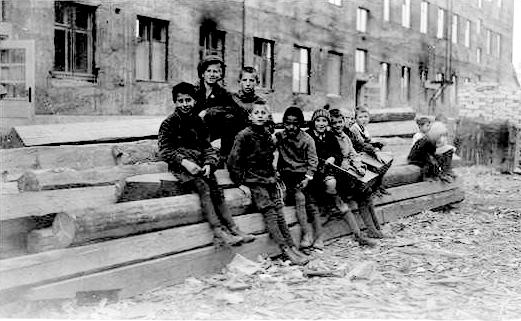
Displaced Children: Country Trends--Russia and the Soviet Union

Figure 1.--This photograph was taken in Rostov sometime in the early-1920s. The photographer was an America, We are guessing they were part of American Relief Administration (ARA) that saved Russians from starving. A caption on the back says that they came scross these children on the way to an 'experimental farm'.
|
|
Russian casualties in World War I were even more severe than those sustantined by the Allies on the murderous Western front. Huge numbers sucumbed to German poison gas attacks. in Russia racked by Revolution and Civil War following World War I, conditions were even worse. Across Russia beginning with World War I but continuing for three decades until well after World War II, conflict and violence connected with wars, foreign and civil, occupation, revolutions, Soviet social and ethnic restructuring, and racial/ethnic persecution resulted in millions of children losing their pasrents and being torn from their homes. [Baron] Large numbers of street children developed. We have noted references to gangs (without the modern coinottions) of childrren coiming ogether in an effort to surviuve.
This was a problem which Soviet authorities inherited. And it was not just the result of the War, but also of the Civil War which followed. Assessments vary on Soviert policies toward them. Some Western scholars
privide positive assessments. [Stolee and Kelly] Tragically, the problem of displaced children did not end with the the Soviet era. One of the most azpauling Soviet actions was the treatment of Ukranian peasant children who made it into the cities during Stalin's Ukranian Genocide.
It is well known that the NAZIs in the Holocaust targeted children. And this has often been used to differentiate the NAZI ans Soviet killing machines and slave lobor camps. And while true to a degree, children were not ignored by Soviet authorities, both for internment in the Gulag. Many children ran afoul of Soviet labor laws and other laws such as sneaking into the fields and 'snipping' crops to releave persistent hunger. [Solzhenitsyn, p. 58 and 89.] They wre often sent out by their starving parents. Another group of children targeted by the Soviets were the children of parents shot by the NKVD or committed to the Gulag. It suddenly occurred to Stalin that they might seek revenge. [Solzhenitsyn, p. 90.] And as part of ethnic exiles and transports to Central Asia and Siberia there were many deaths in the inhumande conditions. Many did not survive these transports. The NKVD did not shoot children, but the elderly and childrn were especially vulnerable as part of the transports. More Russian and other soviet children were displaced during World War II. NKVD actions in countries occupied displaced many foreign children (Poland, Finland, Estonia, Latvia, Lithuania, and Romania) (1939-41). Then with the German Barbarossa invasion, Soviet children were displaced in the millions (1941-45). And Soviet authorities after the War were left with the same problem of gangs (without the modern coinnottions) of street children faced after World War I.
Sources
Baron, Nick. Ed. Displaced Children in Russia and Eastern Europe, 1915-1953 (Brill: 2017).
ISBN: 9789004175303. We have not yet been able to obtain a copy to use for our assessment, but mention it here as an imprtant source, not only for Russia, but all of Eastern Europe. .
Kelly, Catriona. Children's World: Growing Up in Russia, 1890-1991 (New Have: Yale University Press, 2007).
Solzhenitsyn, Alexsanddr I. Trans, Thomas P. Wjitney. The Gulag Archipelago, 1918-56: An Experiment in Literary Investigation (Harper & Row: New York, 1973), 660p.
Stolee, Margaret Kay. "Hoimeless children in the in the USSR, 1917-1957," Soviet Studies. Vol. 40 (1988), pp. 64-83.
CIH

Navigate the Children in History Website:
[Return to War and Social Uoheval: Children]
[Return to Main war essay page]
[Return to Main military style page]
[Introduction]
[Biographies]
[Chronology]
[Climatology]
[Clothing]
[Disease and Health]
[Economics]
[Geography]
[History]
[Human Nature]
[Law]
[Nationalism]
[Presidents]
[Religion]
[Royalty]
[Science]
[Social Class]
[Bibliographies]
[Contributions]
[FAQs]
[Glossaries]
[Images]
[Links]
[Registration]
[Tools]
[Children in History Home]
Created: 6:02 PM 6/24/2017
Last updated: 6:02 PM 6/24/2017



